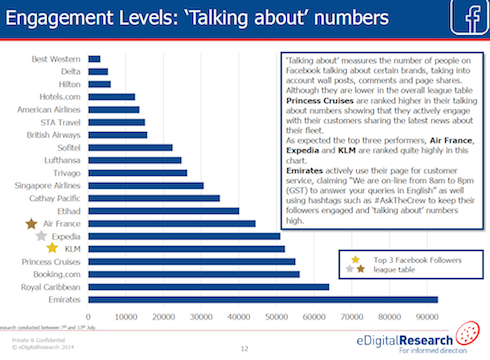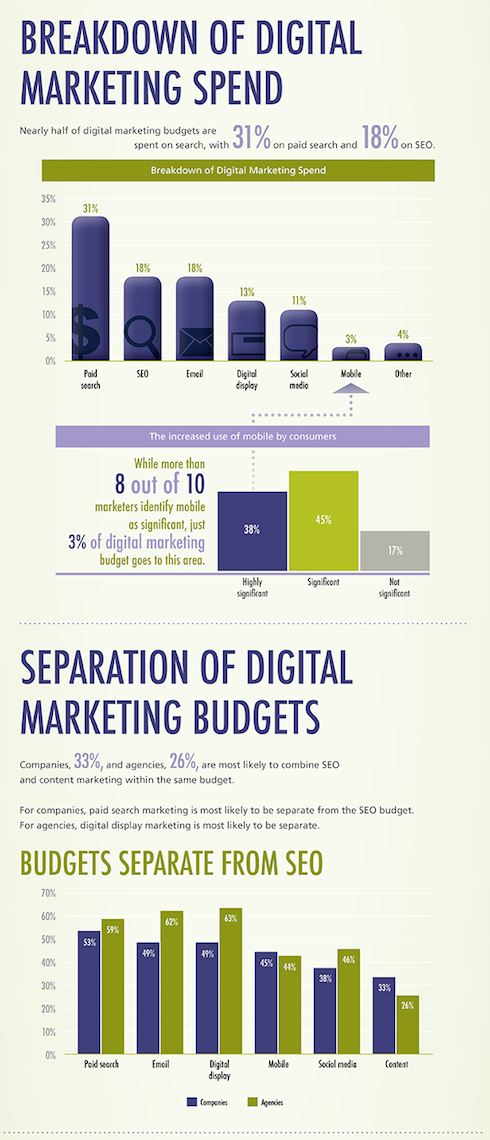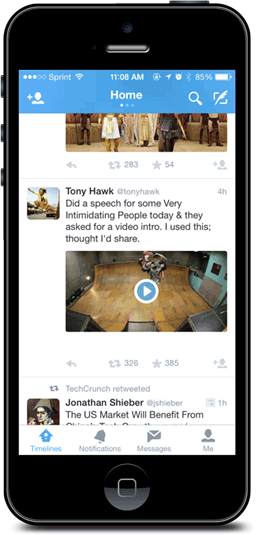By Liam Dowd - August 12th, 2014
New Twitter ad services, social travel success and bouncing sharers
Passport to success
If one market sector has taken massive advantage of social media it’s travel. To support that view, new figures from eDigitalResearch make a number of key conclusions. Now with over 4 million likes on Facebook, Expedia have moved three places up the league table to second - with just Dutch airline KLM sitting firmly above them in first.
Expedia run a global Facebook page with targeted content depending on a follower's country or region. It allows Expedia to engage with audiences on a local level and seamlessly integrate their regional marketing messages, whilst maintaining a global brand presence - and is also most probably a key factor behind this latest social media success.
Derek Eccleston, Commercial Director at eDigitalResearch, comments: "Social media platforms are the perfect way to reach out to a global audience and engage with your customers. As Expedia have shown, using targeted, local accounts within a wider, global social media strategy means that you'll able to speak to customers on their terms and in their language whilst retaining your global brand presence.
“The customer experience really is key these days, and that includes social media platforms. People increasingly see social media channels as a means of getting in touch with companies and engaging with their favourites brands. Therefore brands, especially travel brands, need to have a clear emphasis on customer service as part of their social media strategy".
Making those close personal connections continues to be a tangible way for businesses to leverage social media right across their organisations. The travel industry has clearly understood the power that social media can bring to their sector.
Social spending
New figures in an infographic from Sempo illustrate that even though social media has gained the lion’s share of media coverage, corporations and agencies are still spending the vast majority of their digital marketing budgets on traditional channels such as paid search and email.
The need to spend more on social media is certainly gaining pace, but what is clear is that the desire to support social channels is often not supported with actual financial commitments.
In our 2014 State of Corporate Social Media Briefing, we found that the majority of companies are seeing their social media budgets stagnate.
New tools from Twitter
One of the areas that Twitter has been working hard to optimise is their ad space. Corporations have been using Twitter Ads since 2010 with promoted tweets and promoted accounts. Twitter has now moved on to offer object-based ads.
The company says: “This will make it easier for advertisers to create and optimize successful marketing campaigns — and pay only for the actions that are aligned with their marketing objectives. Objective-based campaigns and pricing are now available in beta to SMBs and API partners globally, and we’ll be rolling this out to managed clients by invitation over the next few months.”
“With objective-based campaigns, we’ll provide a custom workflow aligned to your campaign goals. You can select from a range of key objectives, including driving Tweet engagements, website clicks or conversions, app installs or engagements, followers, or leads.
“Objective-based campaigns are designed to help you drive the highest possible ROI from your ads. Now, you’ll only pay when a user takes an action aligned with your campaign objective. For example, if your goal is to drive leads on Twitter, you’ll only pay when users submit their information via a Lead Generation Card in your Promoted Tweet. By the same token, an app install or app engagement campaign will be charged on a cost-per-app-click (CPAC) model. Objective-based pricing ensures that you only pay for the results that impact your marketing goals.”
The new tool is being tested at the moment. No word yet when the main rollout will occur, but this innovation certainly ads another channel for corporations to use when connecting with potential customers.
Earlier in the year Twitter began to test its Video Card service. Since then the company has been crunching the numbers to reveal that ads that contain native video are highly engaging and sharable. Twitter explains:
“Promoted Video builds upon the Twitter Amplify program, and brings a new set of video tools to high-quality content producers. By using Promoted Video, it’s easy for brands to upload and distribute video on Twitter, and to measure the reach and effectiveness of this content.
“In the spirit of making campaign setup easier, we now offer advertisers the ability to run ads with a new Cost Per View (CPV) ad buying model. This means advertisers only get charged when a user starts playing the video. Additionally, advertisers using Promoted Video have access to robust video analytics, including completion percentage and a breakout of organic vs. paid video views.
“In addition to the improvements we’ve made to the advertiser experience, we’re excited to share that we’ve expanded the tests of our native video solution with select content publishers and verified users. The overall goal is to bring more video into our users’ timelines to create a richer and more engaging Twitter.”
These new developments in how Twitter can now embed video and manage its ad service is more than welcome to corporate marketers. Twitter has proven itself to be a highly effective channel for communications with consumers. So far this has been largely within the customer services space. With these new ad tools maturing, Twitter will take its place alongside Facebook as an essential component of all integrated marketing campaigns.
Bouncing sharers
How long visitors spend on your corporation’s social media channels is the subject of a new report from AddThis. Companies may be obsessed with the number of likes they have, but today marketing is all about attracting and then retaining a visitor so they see your corporation’s content. The research carried out by AddThis indicates that new visitors stay on these pages for very short spaces of time.
“Facebook shares and likes are only a small piece of the content engagement puzzle,” the report says. “That’s because although nearly everyone consumes content, only a small percentage of people share content to the big social networks. An accurate measure of online engagement requires a more granular look at online behaviours that go beyond sharing.
“In analyzing scrolling and engagement activity on pages where the referring URL is a social network or service, 65% of browsers bounced after one page visit. This trend did not differ significantly between desktop and mobile. Promoting medium or long-form content with multiple pages through social networks, therefore, may not be optimal.
“Compared to the average browser seen across the AddThis publisher platform, visitors that scroll pages are 46% more likely to share content to Facebook. Scrollers are also 33% less likely to share content to Twitter. LinkedIn users who scroll or share content are 20% more likely to use a Mac compared with the average user that scrolls or shares content through social networks, and twice as likely to engage with content using an iPad or smartphone.
“’Followers’ or those browsers that follow content are more likely to follow publishers that produce sports and entertainment content, but when it comes to engagement (scrolling, sharing etc.), followers is more likely to engage with finance or business-related content.”
What is clear then is that the type and quantity of the content that is placed on your corporation’s social media channels is important to get right. Content that is quick and easy to scroll through yet imparts its message will gain the most page views and the longest linger rates.
Until next time….
The Useful Social Media team.
Next Reads
September 2014, San Francisco
Use social to get closer to your customer. The Corporate Social Media Summit is your one-stop-shop for all the latest social media insight and best practice.
Brochure Programme


